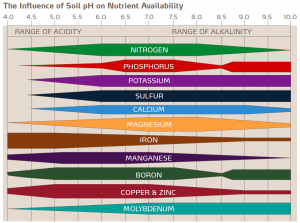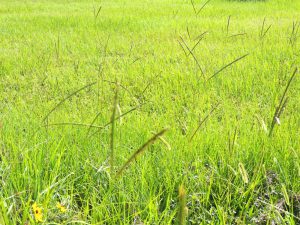Soil pH (potential hydrogen) is an indication of the acidity or alkalinity of soil and is measured in pH units from 0 to 14. Soil pH is defined as the negative logarithm of the hydrogen ion (H+) concentration in the soil. A pH of 7 is considered to be neutral, pH values less than 7 are acidic, and pH values greater than 7 are alkaline.
 Soil pH directly affects the growth and quality of pasture grasses by influencing the chemical form of many elements in the soil as well as soil microbial processes.
Soil pH directly affects the growth and quality of pasture grasses by influencing the chemical form of many elements in the soil as well as soil microbial processes.
In acidic soils, the availability of plant nutrients such as potassium (K), calcium (Ca), and magnesium (Mg) is reduced, while availability of potentially toxic elements such as aluminum (Al), iron (Fe), and zinc (Zn) is increased. In soils (< 5) pH, the availability of boron (B), molybdenum (Mo), and sulfur (S) is reduced, and nutrient uptake as well as forage production can be reduced. Yellowing of forage and damage by soil borne insects may also be noticed at a pH < 5.0. At soil pH < 4.0, there is the potential for aluminum (Al3+) to become toxic to plant roots.
In alkaline soils pH > 7, the availability of micronutrients such as iron, manganese, zinc, copper, and cobalt is reduced and creates forage production problems similar to increased acidity.
Repeated use of nitrogen fertilizer tends to decrease soil pH due to the generation of hydrogen (H+) ions in nitrogen transformations (nitrification). Increase in soil acidity following repeated application of nitrogen fertilizers is naturally countered by soil buffering capacity (clay minerals and organic matter).
Sandy soils tend to have low clay and organic matter content and generally low buffering capacities. Consequently, soil acidity must eventually be neutralized by applying a liming material like calcium carbonate or dolomite which have the ability to increase soil pH. Dolomite has the added benefit of supplying magnesium, which is often deficient in Florida soils.
Field Study
University of Florida/Institute of Food and Agricultural Sciences conducted a ten year research project to evaluate the long-term effect of liming and nitrogen (N) fertilization on dry matter yields, nutritive value, and ground cover of bahiagrass pastures.
A combination of four fertilizer treatments were applied to bahiagrass pastures receiving lime and unlimed pastures. Control (no fertilizer application), and three fertilizer treatments applied in the spring were tested. One ton of dolomite was applied every three years to maintain soil pH of 5 on limed areas. Unlimed pastures had a soil pH of 4.3.
Dry Matter
All of the no-lime plots declined to a pH of about 4.5. Soil pH of the nitrogen fertilized plots without lime declined to 4.3 in three years.
Liming plus nitrogen application improved bahiagrass yield by 30% over plots that received nitrogen fertilizer with no lime. On average, the yield increase from nitrogen fertilizer over the no fertilizer control for both pastures was about 25%.
Nutritive Value
Lime application had little effect on bahiagrass crude protein concentration and digestibility. Conversely, nitrogen application increased crude protein concentration by about 2% (12% versus 10%). The effect of nitrogen application on protein increase was more evident in the spring, immediately after the fertilizer application and generally decreased over time throughout the growing season.
Spring Sod Ground Cover
Damage to bahiagrass sod was more pronounced when soil pH was below 4.5. Two years into into the study, the color of bahiagrass ground cover on pasture B began to decline in response to liming management and fertilizer treatments.

Unlike the unlimed pastures, five years into the experiment, minimum spring color change or damage to bahiagrass sod was noticed for plots limed to pH 5 whether or not they received fertilizer. Sod damage was most severe when bahiagrass pasture was not limed, but received yearly application of any nitrogen containing fertilizer.
The combination of acidic soils (pH < 4.5) and repeated nitrogen fertilization reduced bahiagrass stolon/root biomass by 30 percent.
Recommendations
- When using nitrogen fertilizer, soil should be tested at least every three years. Apply fertilizer according to soil sample recommendations.
- If pH is < 5.3, lime should be applied to correct soil pH. When applying lime/dolomite, be realistic and economical in choosing amount to apply. Apply a minimum of 1 ton of lime when soil test results recommend liming. Avoid over liming. High soil pH > 7 negatively affects forage growth.
- Apply 50 – 60 lb. of nitrogen/acre to bahiagrass in early spring to boost yield and forage crude protein concentration. Additional nitrogen may be needed later during the growing season.
- Repeated nitrogen fertilization with ammonium nitrate or ammonium sulfate can cause substantial decline in soil pH. Look for signs of early spring yellowing.
 0
0
